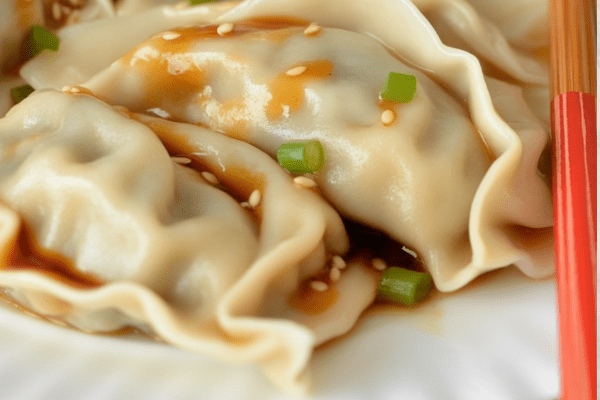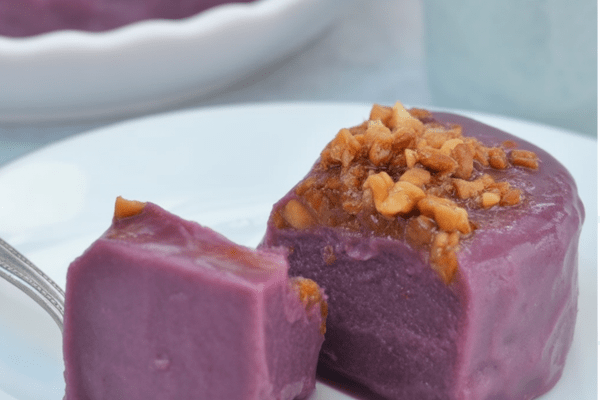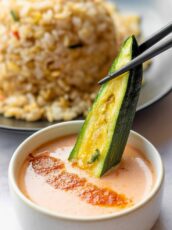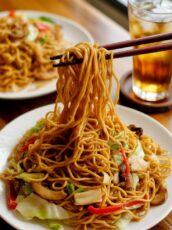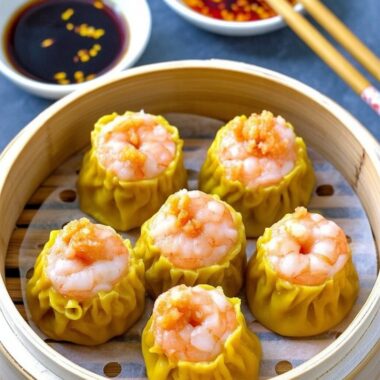If you’ve ever had a steaming plate of nasi lemak, you’ll understand why it’s so beloved across Malaysia and Singapore. This dish is more than just food—it’s nostalgia wrapped in banana leaves. Creamy coconut rice, spicy-sweet sambal, crispy anchovies, peanuts, omelette, and cool cucumber slices—it’s a little bit of everything on one humble plate. Whether you’re recreating breakfast from your last trip to Kuala Lumpur or simply craving something soulful and satisfying, this recipe brings that experience right to your kitchen.
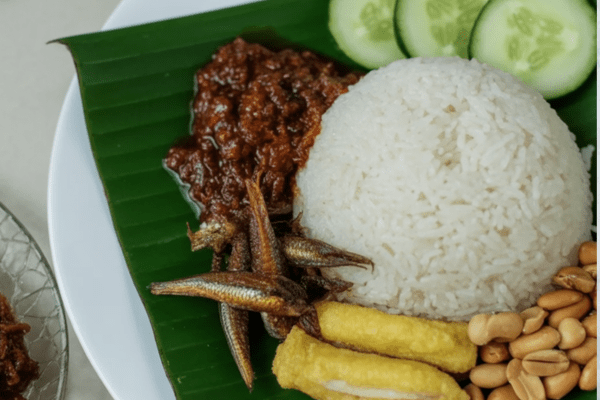
What’s in a Name?
Let’s break it down quickly—“Nasi” means rice, and “Lemak” means creamy or rich. So nasi lemak literally means creamy or rich rice, thanks to the coconut milk it’s cooked in. My niece once asked me why it’s not called “nasi kelapa” (coconut rice), and honestly, I didn’t have a good answer either! It just isn’t, but it’s perfect the way it is.
What is Nasi Lemak, Really?
At its heart, nasi lemak is rice cooked with coconut milk and pandan leaves—fragrant and comforting. But what makes it really special is how it’s served: with sambal (a spicy chili paste), crispy anchovies, peanuts, egg, cucumber, and sometimes a small piece of fried fish. It’s that beautiful contrast of flavors and textures that keeps you coming back for more.
Nasi Lemak Bungkus – A Breakfast Classic
If you’ve been to a hawker stall early in the morning, you’ve probably seen little banana-leaf parcels stacked high. That’s nasi lemak bungkus. Growing up, I used to help wrap these at home for my uncle’s stall. We’d be up before sunrise, rice steaming, sambal bubbling away, and hundreds of little packets flying off the counter before 9 a.m. There’s something magical about how the warm banana leaf infuses the rice with its aroma.
I still wrap it in banana leaves when I make it at home. It’s not just for looks—it genuinely makes a difference in flavor and nostalgia.
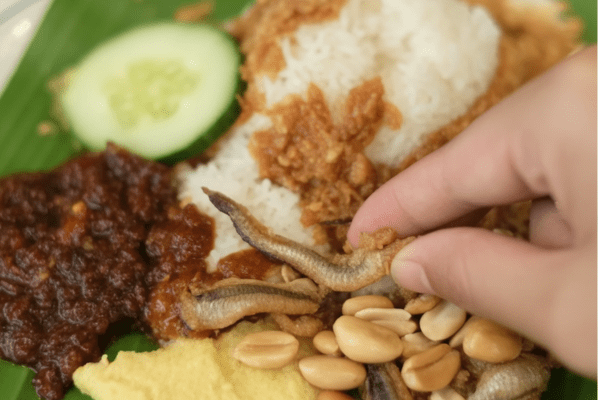
The Perfect Nasi Lemak
Ask ten Malaysians or Singaporeans what makes the perfect nasi lemak, and you’ll likely hear the same answer: rich, fluffy coconut rice and a perfectly balanced sambal tumis. The other toppings? Essential, but those two are the heart.
You might see versions online topped with rendang, fried chicken, or even curry. But if you ask me, those are delicious in their own right—just not in a traditional nasi lemak. The classic version sticks with sambal, cucumber, omelette or boiled egg, ikan bilis, and peanuts. And it’s honestly perfect that way.
Nasi Lemak Deconstructed
Here’s what goes into a traditional nasi lemak plate:
- Coconut Rice
- Sambal Tumis
- Fried Anchovies
- Omelette
- Cucumber Slices
- Toasted or Fried Peanuts
Simple, unassuming—but unbelievably good.
RICE INGREDIENTS
Rice
Long-grain rice is your best friend here—jasmine is my go-to for its fragrance, though basmati works too. You want the grains to stay fluffy and separate, not mushy.
Coconut Milk and Water
Full-fat coconut milk will give you the richest result, but if you’re watching calories, you can use half-fat or dilute coconut cream with water. Just remember to shake the can before using!
For stove-top cooking, a little extra water helps prevent the rice from sticking. In a rice cooker, stick with a 1:1 ratio of rice to liquid. I usually use one can of coconut milk and top it up with water to match the amount of rice.
Pandan Leaves
These fragrant leaves are what give nasi lemak its signature aroma. You can find them frozen in most Asian grocery stores. If you can’t, substitute with a bruised stalk of lemongrass—just don’t add ginger. It changes the whole flavor.

Nasi Lemak Sambal
Pecah Minyak – The Secret to Great Sambal
Here’s the golden rule: cook your sambal until the oil splits. That’s when you know your chili paste has gone from raw and harsh to deep, flavorful, and mellow. It takes around 20 minutes, sometimes more. And yes, you’ll want to stand by and stir—it’s worth every second.
I’ve had sambal that stopped short of this stage, and it’s just not the same. You want that glistening oil pooling around the edges—that’s flavor gold.
INGREDIENTS FOR NASI LEMAK SAMBAL
Dried Red Chillies
These bring depth and intensity that fresh chilies can’t match. I like using a mix—some spicy, some mild (like Kashmiri chilies). Always soak and deseed before blending. Adjust the quantity based on how much heat you like. Just don’t go wild with super-hot varieties like ghost peppers—trust me, you’ll regret it.
Aromatics
Use what you love—brown onions, red onions, garlic. I personally prefer brown onions for their mellow sweetness when cooked down slowly. Just make sure they’re finely chopped or blended into the sambal base.
Tamarind
Tamarind adds that tangy punch that rounds out the sambal. If you don’t have it, white vinegar works in a pinch. Lime juice is also a good substitute—especially for a chili-lime flavor combo.
Gula Melaka
This is a key flavor note—dark, rich, and deeply caramelized. If you can’t find it, go for jaggery or a dark brown sugar and white sugar combo. Avoid Thai palm sugar—it’s too light for this.
Dark Soy Sauce
This is optional but I love the umami depth it adds. Just a splash can elevate the whole dish. Sweet soy sauce (kicap manis) also works if that’s what you have.
THE OTHER NASI LEMAK CONDIMENTS
Dried Anchovies (Ikan Bilis)
These are non-negotiable for me. Fry them till crisp and golden—they add crunch and a salty kick that pulls the dish together. If you’re buying whole ones, budget some time for cleaning. I’ve spent many early mornings pinching heads off anchovies, and I still do it when I can’t find pre-cleaned ones.
Omelette
Soft strips or squares of plain omelette give a lovely balance to the spiciness of the sambal. Boiled eggs are sometimes used too, especially when cooked right into the sambal.
Cucumber Slices
They’re not just there for color. That cool crunch is the reset button between spicy bites. I usually slice them a little thick to hold their texture.
Peanuts
Toasted peanuts round off the plate with some earthy crunch. I usually use salted roasted ones straight from the jar—less effort and still so tasty.
How to Serve Nasi Lemak
Traditionally, it’s served warm, wrapped in banana leaves for that added aroma. At home, I like to recreate that same charm by placing a piece of banana leaf on the plate. It’s such a sensory experience—smelling that leaf as the steam hits it. And don’t forget, nasi lemak is often eaten with fingers. There’s something so satisfying about scooping rice and sambal with your hands.
How to Store Leftovers
If you’ve got leftovers, store each component separately in the fridge. The sambal lasts up to a week and even improves with time. The rice can be reheated gently in the microwave with a splash of water to bring back its fluffiness. Anchovies and peanuts stay crisp in an airtight container at room temperature.
Malaysian Nasi Lemak Sambal

Looking for the perfect Nasi Lemak recipe? This one has been used every morning for years in a catering kitchen — simple, authentic, and incredibly delicious.
Ingredients
For the Rice:
- 750 g Basmati or Jasmine rice
- 800 ml coconut milk (if using a rice cooker, total liquid should be 900 ml — see notes)
- 300 ml water
- ½ tsp salt
- 2 pandan leaves, tied in a knot
Sambal Nasi Lemak:
- 30–50 g dried red chillies
- 500 ml very hot water (for chillies and tamarind)
- 2 heaped Tbsp tamarind pulp or 2 Tbsp store-bought paste
- 2 medium onions (approx. 300 g, peeled)
- 3 cloves garlic (15–20 g, peeled)
- 60 g gula melaka (see notes for substitutes)
- 2 heaped Tbsp dried anchovies (ikan bilis)
- 125 ml room temperature water for blending
- 4 Tbsp vegetable oil
- ½ Tbsp dark soy sauce
Other Condiments:
- 120 g peanuts (approx. 1 heaped Tbsp per person)
- 120 g dried anchovies
- 4 eggs
- 16 slices cucumber
- 125 ml vegetable oil
Instructions
- Coconut Rice: Begin by thoroughly rinsing the rice several times until the water appears mostly clear. Transfer the cleaned rice into a pot, then add coconut milk, water, salt, and pandan leaves. Heat the mixture gently over medium-high heat until it starts to simmer. Once simmering, lower the heat, stir the contents, cover tightly, and let it cook on low for about 15 minutes, stirring once midway to prevent the rice from sticking. Once cooked, remove from heat but keep the lid on and allow it to sit for 10 minutes. Fluff the rice with a fork before serving and discard the pandan leaves.
- Using a Rice Cooker: Rinse the rice a few times and place it in the rice cooker. Add coconut milk, water, salt, and pandan leaves, ensuring that the total liquid matches the amount of rice (e.g., 5 cups of rice to 5 cups of liquid). Use the rice cooker's measuring cup for best results. Cook using the standard rice function. When done, fluff the rice and remove the pandan leaves.
- Sambal: Soak chopped dried chillies in boiling water for about 15 minutes, keeping some hot water aside for tamarind use. If using tamarind pulp, soak it in 125 ml of hot water and set aside uncovered. This step isn't necessary if you're using tamarind paste.
- Peel the onions and cut them in half. Slice one half thinly and keep it aside. Roughly chop the other half with the garlic and place them in a blender. Pre-grating can help speed up blending. After soaking, drain and rinse the chillies, removing about half of the seeds to reduce heat. Add the chillies to the blender with the chopped aromatics, anchovies, and a bit of the reserved tamarind water. Blend until smooth.
- Heat oil in a pan over medium heat and add the blended paste. Sauté for a few minutes, then lower the heat and continue to cook for 15 to 20 minutes, stirring frequently to prevent burning. Once the oil begins to separate from the paste, add tamarind juice, gula melaka, salt, and the reserved sliced onions. Let it simmer for another 5 minutes, then stir in soy sauce and cook briefly. Taste and adjust the seasoning as needed. The final sambal should be spicy, flavorful, and slightly sweet. Cool it before storing—it can be refrigerated for up to five days.
- Crispy Anchovies: For raw anchovies, start by frying them briefly in hot oil, then drain on paper towels and keep the oil. Return the anchovies to the reserved oil and fry again until they become crisp and golden. Watch closely to avoid burning.
- Omelette: Beat the eggs with a little salt and cook them into thin omelettes. Once cooled, slice them into strips or bite-sized pieces.
- To Serve: Plate the coconut rice and top with sambal, crispy anchovies, egg strips, roasted peanuts, and cucumber slices. Offer extra sambal or condiments on the side so everyone can personalize their meal.
Notes
- Recipe can be scaled up or down as needed.
- Adjust condiments to taste. For example, increase peanuts to 2 Tbsp per person if preferred.
Nutrition Information:
Yield: 8 Serving Size: 1Amount Per Serving: Calories: 889Total Fat: 53gSaturated Fat: 24gTrans Fat: 0gUnsaturated Fat: 26gCholesterol: 121mgSodium: 1649mgCarbohydrates: 82gFiber: 8gSugar: 24gProtein: 32g
Asianplated.com, occasionally offers nutritional information for recipes contained on this site. This information is provided as a courtesy and is an estimate only. This information comes from online calculators. Although allchickenrecipes.com attempts to provide accurate nutritional information, these figures are only estimates.
FAQs
Can I make the sambal ahead of time?
Absolutely. In fact, it’s even better the next day once all the flavors have melded together.
Can I freeze nasi lemak rice?
You can, but fresh is best. If freezing, portion it out and thaw overnight in the fridge before gently reheating.
Is nasi lemak always spicy?
The sambal is meant to have a mild heat with a hint of sweetness, not burn-your-mouth hot. You can always reduce the chili quantity to suit your preference.
Can I make a vegetarian version?
Yes—just skip the anchovies and use a vegan sambal. It’s still deeply satisfying.
Try other recipes:

